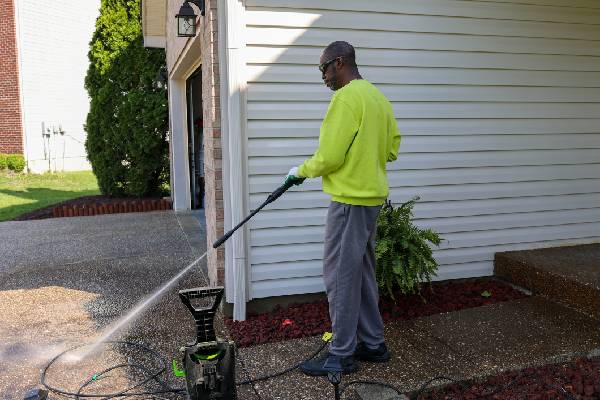
Pressure washing is one of the most satisfying ways to clean — watching years of dirt and grime blast away in seconds is downright addictive. 😍 But with great power comes great responsibility. Misuse that water pressure, and you could seriously damage your property instead of cleaning it. 😬
From splintered wood to etched concrete and even broken windows, high-pressure water can cause more harm than good if used incorrectly. So how do you enjoy the benefits of a pressure washer without leaving destruction in your wake?
This article will walk you through safe, damage-free power washing practices so you can clean like a pro — without costly mistakes. 💦👨🔧
🚧 Common Pressure Washing Mistakes That Cause Damage
Let’s start by understanding the most common ways surfaces get damaged during pressure washing:
❌ Using Too Much Pressure
Not every job needs 4,000 PSI. Using the wrong setting on delicate surfaces like wood, siding, or windows can tear, gouge, or break them.
❌ Holding the Nozzle Too Close
It might seem like holding the nozzle a few inches from the surface gives a deeper clean, but this can actually strip paint, dent siding, and erode concrete.
❌ Using the Wrong Nozzle
Each nozzle has a different spray angle — using a 0° tip (red nozzle) on vinyl siding or wood is a recipe for disaster. 🔺
❌ Ignoring Surface Conditions
Cracked concrete, loose shingles, or rotting wood can all be made worse by high-pressure water.
❌ Washing at the Wrong Angle
Spraying upward at siding or under shingles can force water behind protective layers, leading to mold, rot, and leaks.
🧠 Know Your Surfaces: What’s Safe and What’s Not?
✅ Safe to Pressure Wash (With the Right Settings):
- Concrete and brick
- Vinyl siding
- Metal surfaces
- Stone pavers
- Fences and decks (with care)
⚠️ Use Extreme Caution:
- Wood siding
- Painted surfaces
- Asphalt shingles
- Windows and glass
- Vehicles and small equipment
❌ Avoid Pressure Washing:
- Softwood furniture
- Electrical fixtures
- Air conditioning units
- Old mortar or cracked concrete
- Lead-painted surfaces
🛠️ Choose the Right Nozzle
Nozzles control the spray angle and pressure concentration. Here’s a quick guide:
| Color | Angle | Use |
|---|---|---|
| 🔴 Red | 0° | Not recommended — very aggressive, only for tough stains on concrete |
| 🟠 Yellow | 15° | Concrete, brick, tough surfaces |
| 🟢 Green | 25° | General use — patios, decks, fences |
| 🔵 White | 40° | Windows, vehicles, softer surfaces |
| ⚪ Black | 65° | Soap application only (low pressure) |
👉 Stick with green or white for most household cleaning — they offer enough pressure without risking damage.
Browse Amazon Here For Top Rated Power Washers And Accessories
📏 Maintain the Proper Distance
A good rule of thumb is to start 2 feet away from the surface and slowly move closer only if necessary. Here’s a quick breakdown:
- Concrete & stone: 6–12 inches
- Vinyl siding: 12–24 inches
- Wood surfaces: 18–24 inches
- Glass/windows: 24+ inches (use low pressure!)
🧠 Pro Tip: Always do a spot test in an inconspicuous area before tackling the whole surface.
🌊 Use the Correct Pressure Setting
Most pressure washers offer adjustable PSI levels. Use the right amount of power for the job:
| Surface | Recommended PSI |
|---|---|
| Wood deck | 500–1,200 PSI |
| Siding | 1,300–1,800 PSI |
| Concrete/driveway | 2,500–3,500 PSI |
| Vehicle | 1,200–1,900 PSI |
| Brick | 1,500–2,500 PSI |
Too much pressure is the most common cause of damage — err on the lower end and increase only as needed.
💦 Use Detergents, Not Just Force
Many people try to clean using just water pressure. But combining water with the right detergent means:
- Less pressure needed
- Safer cleaning
- Better results
Use a pressure washer-safe soap or degreaser, apply it with a soap nozzle, let it dwell for 5–10 minutes, then rinse gently. It’s more effective and gentler on surfaces. 🧴🧼
🧽 Always Clean in the Right Direction
When washing siding, shingles, or wood panels:
- Always spray with the grain or direction of the surface
- Never spray upward into siding or roof lines
- Work top to bottom to prevent streaking
Spraying at the wrong angle can force water behind siding, causing long-term moisture damage.
👷 Safety First: Protect Yourself and Others
- Wear goggles, gloves, and closed-toe shoes 👟
- Never use a ladder while pressure washing (the recoil can throw you off)
- Keep pets, kids, and breakables away from the area
- Don’t point the nozzle at people or animals — it can cut skin and cause injury
🧰 Optional Tools That Help Reduce Risk
✅ Surface Cleaners
Great for driveways and patios — they distribute water evenly and prevent streaks or gouging.
✅ Extension Wands
Useful for high areas like second-story siding or gutters — keep your feet safely on the ground.
✅ Soft Wash Systems
Use low pressure combined with special detergents — ideal for fragile surfaces like roofs and painted siding.
🧽 Final Thoughts
Pressure washing is an amazing way to revitalize your home’s appearance, but only when done correctly. The line between a clean surface and a ruined one is thinner than you might think — and just one wrong move with the wrong pressure or nozzle can cost you hundreds in repairs. 😬
By understanding your equipment, your surfaces, and the proper techniques, you can tackle any power washing project with confidence — without causing damage. 👏
So take a step back, check your settings, and clean smarter, not harder. 💦
Browse Amazon Here For Top Rated Power Washers And Accessories



